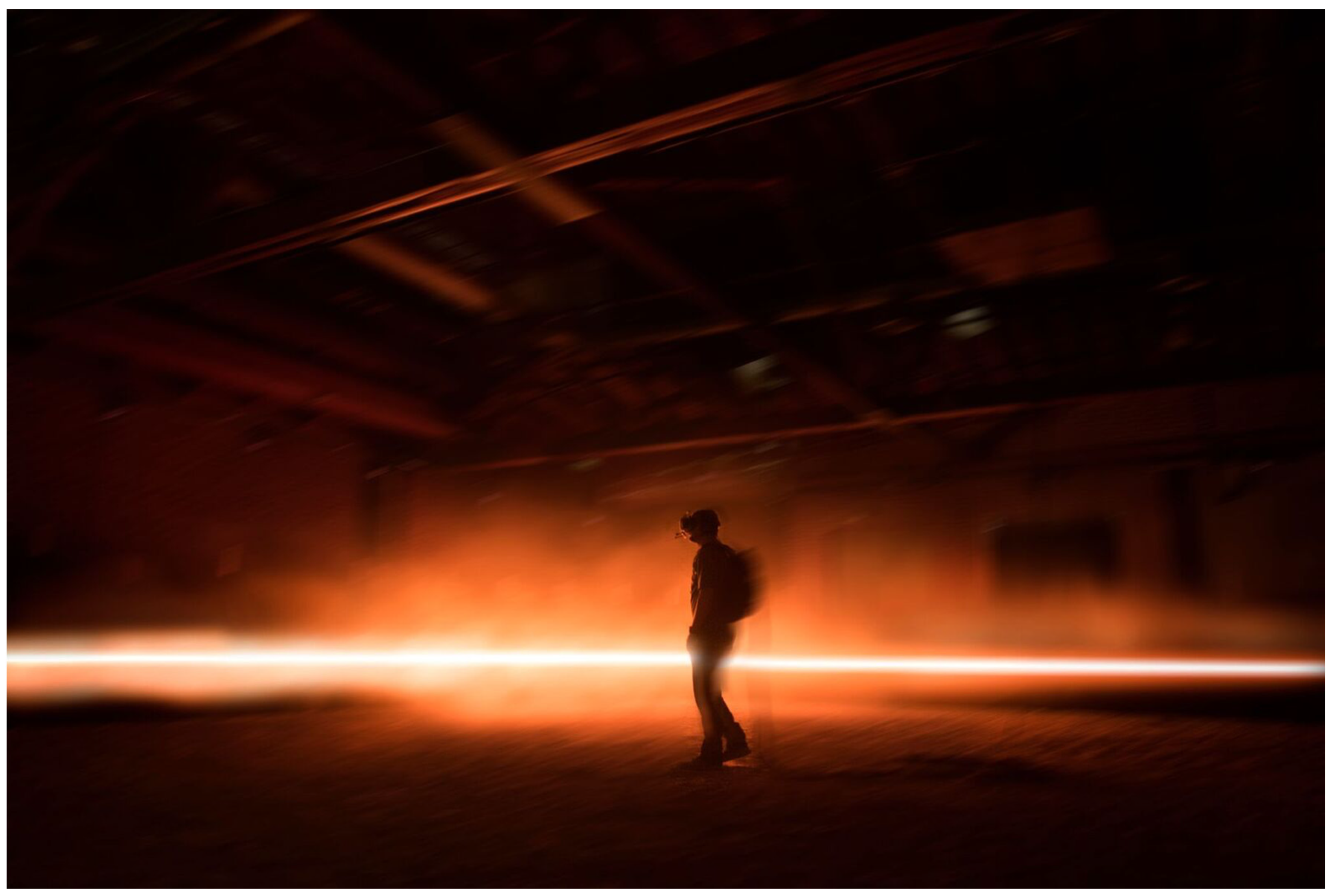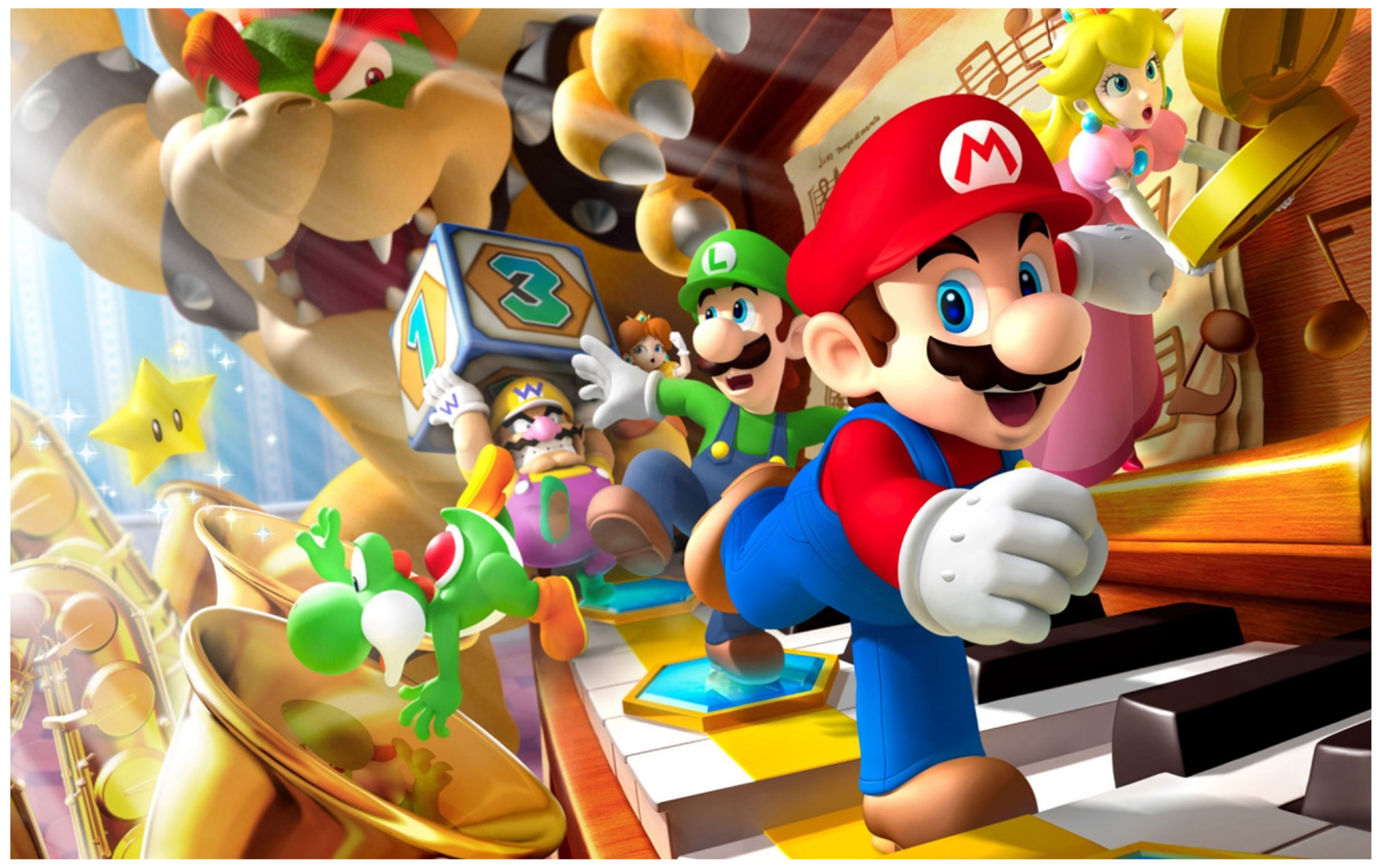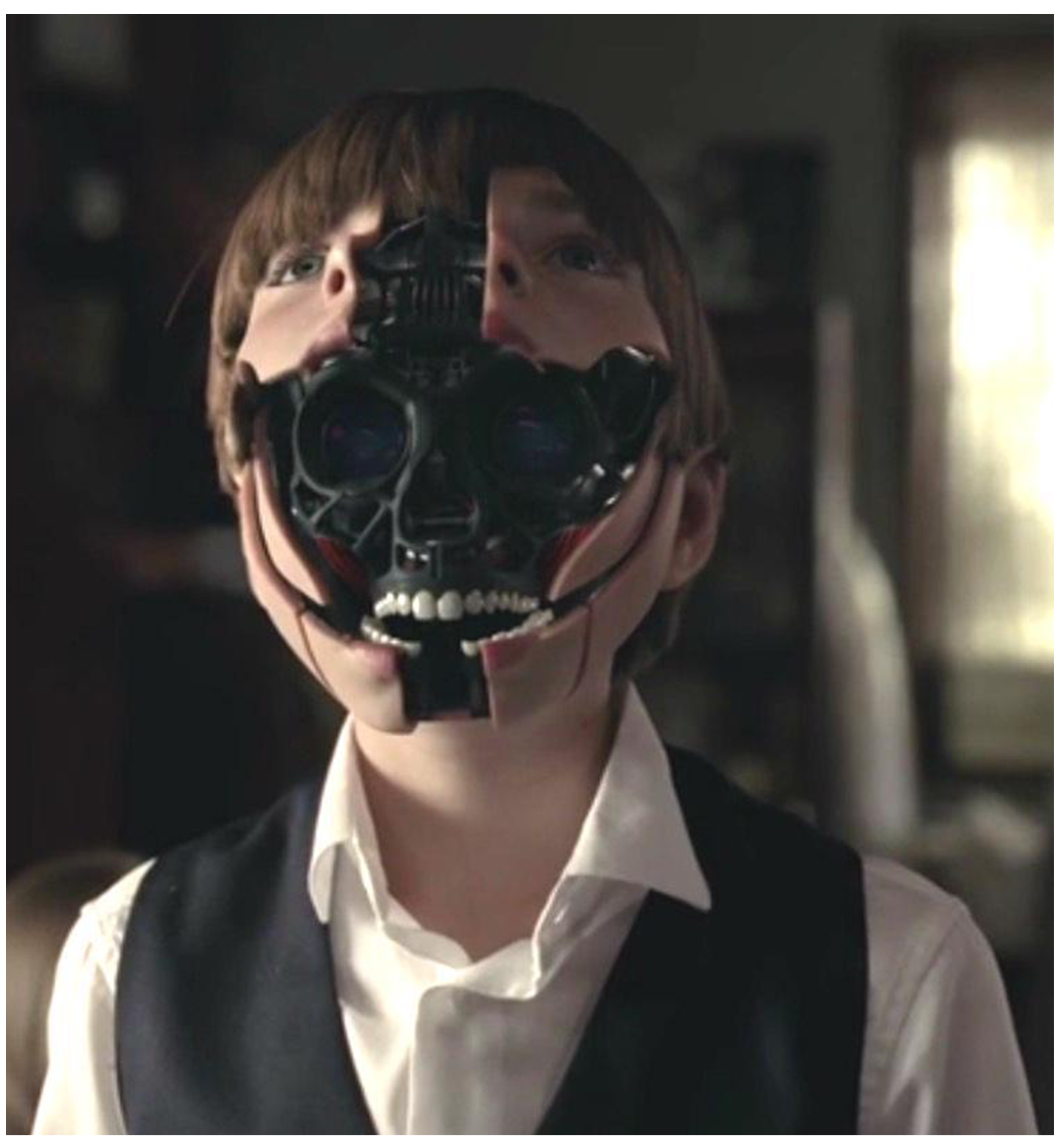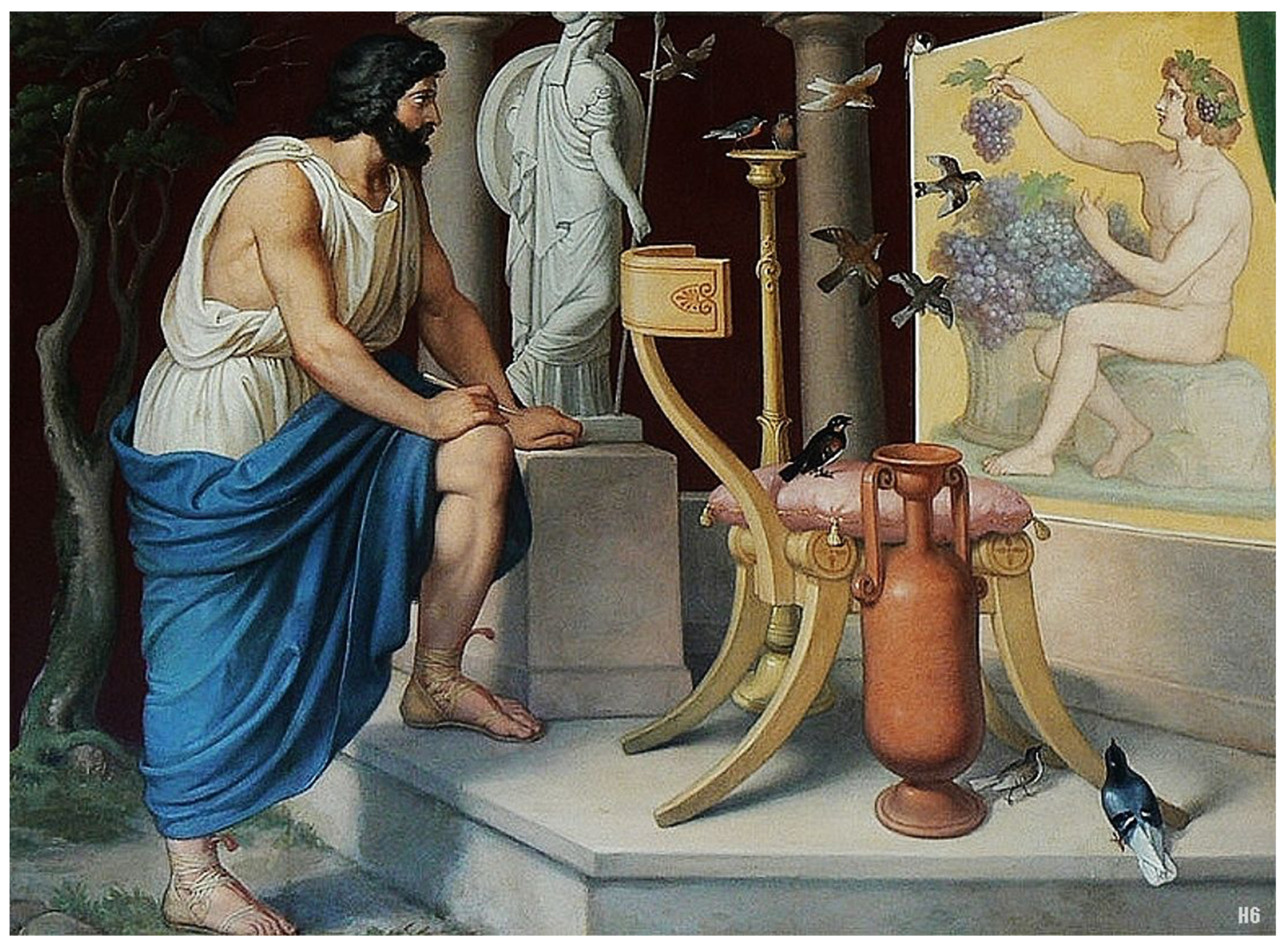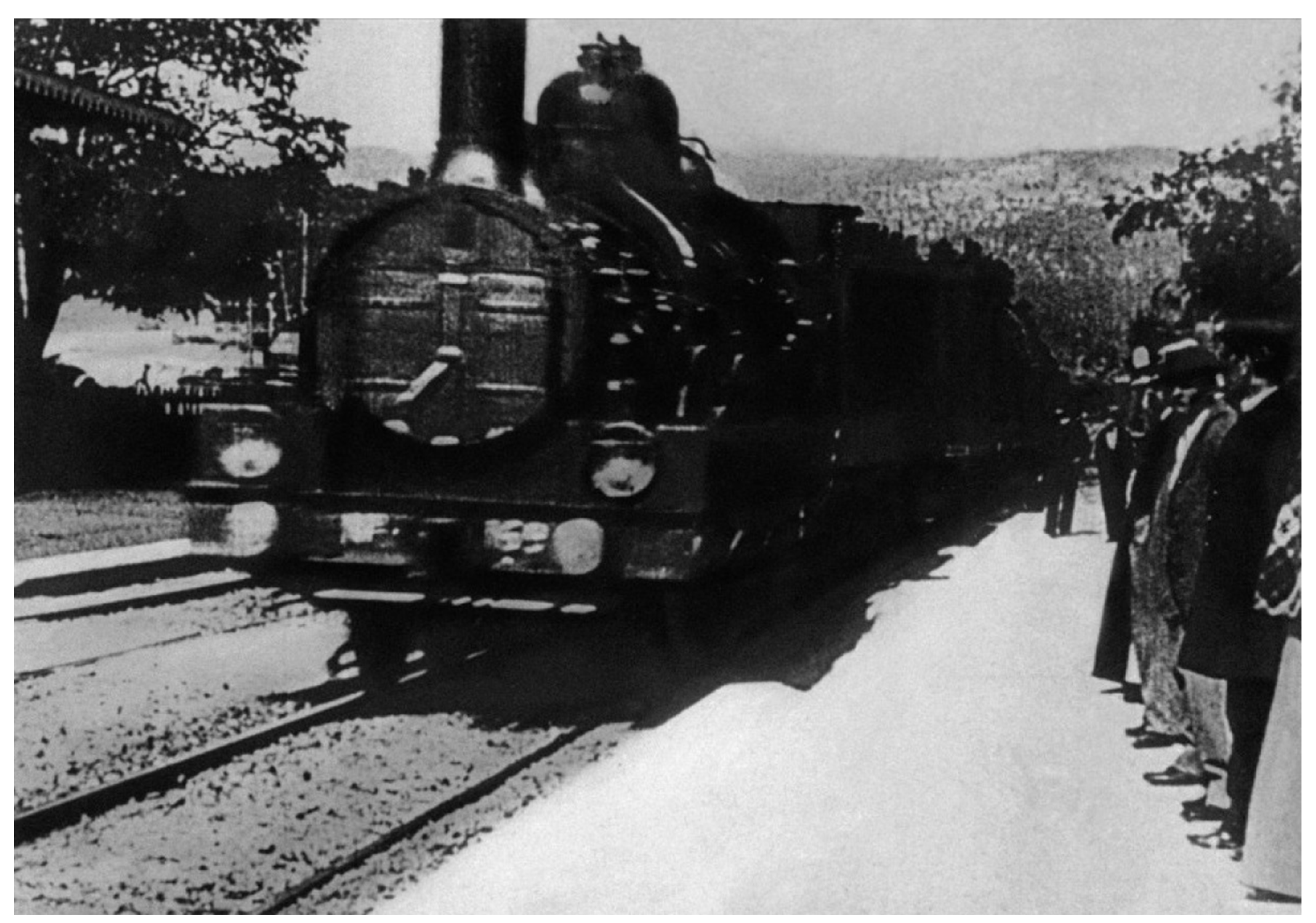1. Introduction
The contemporary scenario of image production and consumption is characterized by an ever-increasing blurring of the distinction between image and reality. Immersivity and interactivity in virtual environments are able to elicit in the user an intense feeling of “being there”, namely of being embodied in an independent and self-referential world. Images are consequently transformed into habitable environments, which tend to negate themselves as representational images of something—i.e., as icons: they are veritable “an-icons”. As such, they undermine the dominant paradigm of Western image theories (shared by the classical doctrine of mimesis, the phenomenological account of image-consciousness, the analytic theories of depiction, the semiotic and iconological approaches) based on the notion of “re-presentation”. This notion overlooks the crucial point regarding an-icons: the feeling of “presence” associated with inhabiting the image-world. “Presentification” rather than representation is here the key issue. Subjects relating to an-icons are no longer visual observers in front of images isolated from the real world by a framing device: they become experiencers living in a quasi-world that offers multisensory stimuli and allows sensorimotor affordances and interactions.
Nowadays, digital natives grow up interacting with touch screens since their youngest age; however, in relation to immersive virtual environments (VEs) they are still “immigrants” who need to acquire familiarity with an-iconic transformations of sensibility. However, given the rapid pace of technological development and the huge amount of economic and scientific investments on a global scale, digital an-iconic natives are to be expected in the very near future. Head-mounted displays (HMDs) are already in use for personal computers (Oculus Rift and HTC Vive) and video game consoles (Sony PlayStation VR), or mimicked by low-budget smartphone wearables (Google Cardboard and Samsung Gear VR). The imminent release of increasingly cheaper and standalone devices has already been announced for 2018 by Vive and Lenovo. Facebook is currently beta testing its virtual reality (VR) app Spaces.
My paper will tackle this urgent challenge that is going to radically change human relations to images and to experience as a whole. Moving from a specific case-study (Alejandro G. Iñárritu’s virtual installation Carne y Arena), it will address the key-concepts and the main methodological issues related to an-iconology as a transmedial and transdisciplinary approach to self-negating images.
2. Present and Invisible
At the 2017 70th edition of the Cannes Festival, Alejandro G. Iñárritu did not present a film. He decided to participate with the world premiere
Carne y Arena, an installation of virtual reality now staged at the Fondazione Prada di Milano (that co-produced it). Intending to narrate the odyssey of the Mexican migrants trying to trespass the border and to enter the United States, the filmic medium did not appear adequate to him [
1]. If you want to see it (better said, if you want to
experience it), you must reserve your individual session on the website. As a first step, you have access at a scheduled time to a preparatory anteroom: a cold chamber (evoking
las hieleras, the “cool boxes”, as they call the cells for initial reception of the migrants taken prisoner by the border guards. Shoes and sandals are scattered on the floor: they were lost by those desperate people (and if you lose your footwear in the desert, you are doomed), and were collected by an association that helps the Mexicans in search for the American Dream. You must take off shoes and socks, put them in a safe, stand barefoot on the frigid floor; and wait. Finally a signal breaks the suspension that was starting to make you nervous: you open a heavy metal door, you go in and you find yourself in a dark room; your feet are on the sand (coarse grain, rough feeling). Two assistants welcome you and provide you with the necessary devices: an Oculus Rift, an headset, a backpack connected via cables to a powerful computer. You are ready to be caught up in a nightmare (
Figure 1).
I said: “if you want to
experience it”, rather than to “see it”. “Seeing” is already improper for a movie: you watch it and hear it, it is an audio-visual medium. But here the sand under your feet and the wind add a tactile dimension. And in certain moments you even imagine the odours: of the desert, of the bushes, of the wild animals. Of the sweat produced by effort and fear. Of the bad breath of fugitives and policemen who did not sleep. There are actually no smells in
Carne y Arena. Soon, however, we will perceive them in similar environments. The endeavours to implement multisensory stimulations go hand-in-hand with the attempt to create images that appear less and less distinguishable from reality: images negating themselves qua “images-of” something which is in turn not an image, but reality; images which are paradoxically an-iconic and which challenge the condition of insularity—traditionally ensured by a framing dispositif delimiting either the canvas (See the classical studies by [
2,
3]) or the screen [
4,
5]—of separatedness, a property which made the “imageness” of an image, in order to institute a space-time which is compatible and coherent with the real space-time. An-icons are images becoming
environments provided with
agencies and
affordances: in corresponding to these stimuli, the spectator becomes a veritable “experiencer”.
Carne y Arena bears a subtitle: Virtually Present, Physically Invisible. In its double specification, this subtitle clarifies, respectively, virtues and limits of Iñárritu’s installation.
Virtually Present: you are transported in the middle of the desert, among men, women, and children who try their voyage of hope. You move with them, they are not just in front of you, but beside and behind you, you feel them even when you do not directly perceive them. You explore the wild space fraught with peril in the uncertain night light. A helicopter menacingly hovers above you with its intrusive headlight nailing you to the ground. The border guards keep hysterically shouting at you with their shotguns pointing at your face. The visual field, integrally saturated like in natural vision, seals you off in the virtual environment (the importance of this 360° hermetic seal see [
6]). There are no edges or frames that can help you distinguish what is inside and what is outside the image. The sensation of “presence”, of “being-there”, is very intense. Since 1980, when Marvin Minsky coined the term of “telepresence” to designate the remote operator’s feeling of being “elsewhere” than in one’s actual physical position, so-called “presence studies” have strongly grown, also adopting measurement tools [
7,
8]. Reflecting on the situation of the contemporary “media environment” (the concept of medium as
milieu, atmosphere,
Umwelt,
environment see [
9,
10]), Hans Ulrich Gumbrecht (the main contributor to a renewed interest in the field of humanities for the notion of “presence”) underlines its paradoxical nature: “It has alienated us from the things of the world and their present—but at the same time, it has the potential for bringing back some of the things of the world to us” [
11] (p. 140). It is the logic of “transparent immediacy” described by da Bolter e Grusin [
12]: an apparent non-mediatedness of the immersive media environments that is obtained through the employment of highly sophisticated technological mediations. It is a complex experiential phenomenon that mixes virtuality and embodiment, participation and empathy (not necessarily towards the migrants: we might just as well imagine an experiencer sympathizing with the policemen) in an intimate intertwinement (the relationship between empathy and immersivity see [
13]): it is a particular “variety of presence” still waiting for an adequate phenomenological description (It is a specific “variety of presence” that deserves a deeper analysis than the one devoted by recent studies on presence, such as [
14,
15]).
Physically Invisible: you are present, but nobody sees you. The migrants with whom you are walking cannot see you. The policemen who seem to shout at you, pointing torches and guns in your direction, cannot see you either. You are invisible even to yourself: if you look down at your feet, that you feel on the sand, you do not see them. If you stretch an arm in front of your eyes, nothing appears in your visual field. So, you start feeling the need to be noticed, to make them realize that you are there (after all, you are “present”). Since nobody perceives you, you approach those bodies with your own body, you try to touch them, even to hit them. You feel powerless, and in need of urgent acknowledgment, of social recognition, which nevertheless is destined to remain unanswered because of the limits of the dispositif: the virtual bodies “explode” when you hit them, transforming themselves in a beating heart.
3. The An-Iconic Gradient
Limits of this kind—which are typical of immersive environments—have been made the object of a critical reflection by Gordon Calleja, who underlines the difference between immersivity and interactivity (the notion of “interactivity” see [
16,
17]): the former being environments in which you are merely transported in a subjective “being-there”, the latter being systems which recognize you as effectively present, allowing you to perform things thanks to the possibility of
incorporation [
18]. Here we are confronted with the complex issue of the
avatar subjectivity (the notion of “avatar” see [
19,
20]): a representative of the self in the virtual world, which is perceived both by the other actors of the media environment and by the self, with all the questions related to the institution of a virtual supplementary identity, of a
Doppelgänger which comes to interact on one’s behalf with things and persons that are also virtual.
Immersivity and interactivity are only two of the many aspects that an-iconology as a methodological approach addressing self-negating images must take into consideration. A major question concerns the necessary and sufficient conditions in order to have an-iconic images. The conditions posed by Calleja seem very restrictive: they are basically satisfied only by certain video-games in which the system’s capacity to recognize you within itself is combined with interactivity [
21]. Calleja excludes from the necessary conditions the illusionistic and hyper-realistic effect (I can incorporate myself into Super Mario as well (
Figure 2), provided that interactivity is ensured).
On the contrary, the authors of the series
Westworld (Jonathan Nolan and Lisa Joy for HBO, 2016) have chosen a 360° “amusement” park in which the androids are undistinguishable from the human beings, and precisely this hyper-realistic feature is valued as a guarantee for full immersivity (“We sell complete immersion”:
Figure 3).
In my opinion, an-iconicity is less to be considered as a property which is either present or absent (according to the model
on/
off) than as a
gradient property which is located on a scale from a minimum to a maximum (this latter intended as a limit open onto the future). The adoption of the gradient model enables full exploitation of a fruitful heuristic perspective: it is not only interesting to understand what kind of experience we make of contemporary an-icons, but also to retrospectively reconstruct their genealogy, tracing back the origins of the an-iconic drive to the Palaeolithic cave paintings. With the aid of art history and media archaeology [
22,
23,
24], we can explore different modalities that have challenged the threshold separating the real and the iconic world throughout the history of images, resulting in
osmotic media environments (see the pioneering work
Osmose by Char Davies:
Figure 4) [
25], and aiming at different forms of presence, immersion, interaction, variously combined.
As mentioned before, if the frame and the screen are among the major dispositifs which have ensured the separatedness of the “images-of”, a particular attention will have to be devoted to those strategies that have questioned their status of limit or barrier, according to a two-way movement in/out: elements of the real world penetrating into the fictional space delimited by the frame or by the screen; elements escaping from the iconic world to settle in the real one.
The history of images abounds with examples. As for the history of painting, let us think of the legend of the Chinese painter Wu Tao-tzu disappearing in his own picture (a story that fascinated Benjamin, Kracauer, Béla Balázs, and many others) [
26]. As for the history of cinema, we can recall
Sherlock Jr. by Buster Keaton (1924) and the homage paid to him by Woody Allen in
The Purple Rose of Cairo (1985). David Cronenberg’s
Videodrome (1983) articulated this
topos in a television setting, while Steve Barron developed the same idea in his rotoscoping video for the A-ha’s song
Take on Me (1986). Parodies have also capitalized on this theme: the trailer of the prequel
The Ring 3 offers an eloquent example.
4. A Transmedial and Transdisciplinary Approach
A
transmedial archaeological approach enables us to seize an-iconic family resemblances among objects that can be very distant in time or in their medium-specificity. Let us compare for instance the following texts: “Birds fly from the auditorium into the screen or settle quietly over the heads of the audience on wires tangibly stretching from what used to be the surface of the screen to the projector”/“… a picture of grapes so successfully represented that birds flew up to the stage-buildings”. The first passage is by Sergei Eisenstein, who in the Forties had imagined a stereoscopic cinema (a forerunner of the contemporary 3D cinema), capable “to ‘draw’ the audience with unprecedented force into what used to be a flat surface and the ability to ‘bring down’ on the audience that which formerly spread over the surface of the screen” [
27,
28] (pp. 132–133). The second passage comes from Pliny’s
Natural History (35, 65) and relates the famous contest between Zeuxis and Parrhasius competing to realize the most illusionistic picture [
29,
30] (
Figure 5). Centuries separate these two texts, and nevertheless they both refer to birds behaving as if the iconic space and the real space were mingled together in one environment in which they can freely fly around.
An entire spectrum of an-iconic solutions spans from Zeuxis’ birds to the interactive and immersive environments—whose diffusion goes not casually hand in hand with the increasing
liquidity of contemporary culture [
31]: all pursue with obstinacy the ancient dream of producing images that are indistinguishable from reality (a dream that might also be worth considering from an evolutionary point of view). On the intermediate steps of the ladder we find—at different levels of an-iconicity—the techniques of
trompe l’œil and of perspective, the
camera obscura and the stereoscopes, dioramas and panoramas, holograms, etc.
The task of establishing a scale of an-iconicity is not without risk. Firstly, one has to beware of a continuistic and deterministic teleology that would result in a smooth narrative leading to the perfect an-icon. Media archaeology will have to be tempered with media genealogy [
32]: discontinuities, ruptures, and counter-tendencies will have to be carefully evaluated in order to dialectically understand the an-iconic drive. Secondly, it is necessary to resist the temptation to assess the an-iconic effects of a particular dispositif according to a unit of measurement which is tailored on the profile of the contemporary experiencer of virtual immersive and interactive environments. Such an experiencer would smile at the anecdotes relating of Zeuxis’ birds or of spectators escaping from the theatre at the first projection of Lumière Brothers’
L’arrivée d’un train en gare de La Ciotat (1895) (
Figure 6) [
33].
The experiencer is not only and not necessarily the contemporary one, but not even an abstract and disembodied subjectivity: the experiencer must be investigated time after time
iuxta propria principia, as a subject or as a community that are culturally and historically situated, and that can perceive an-iconic effects according to aesthesiological and mediological parameters that might also be very different than ours. Here the study of an-iconic images intersects the problematic and controversial issue of the historicity of perception: how is it possible to adequately describe “scopic regimes” that are far from our condition in time and space [
34,
35,
36,
37,
38,
39]?
The task is clearly not simple: it is necessary to develop a
transdisciplinary approach able to combine phenomenology and cognitive sciences, cultural anthropology, and history of technology, art history, and media archaeology within a techno-aesthetical frame [
40]: technique is not to be conceived of in opposition to anatomy, the artificial is not to be understood as antithetical to the natural. Technical prostheses are a natural extension of the human perception and action. The human beings are naturally technical. This is the perimeter that circumscribes the possibility of a history and theory of self-negating images: namely, the possibility of
an-iconology.
